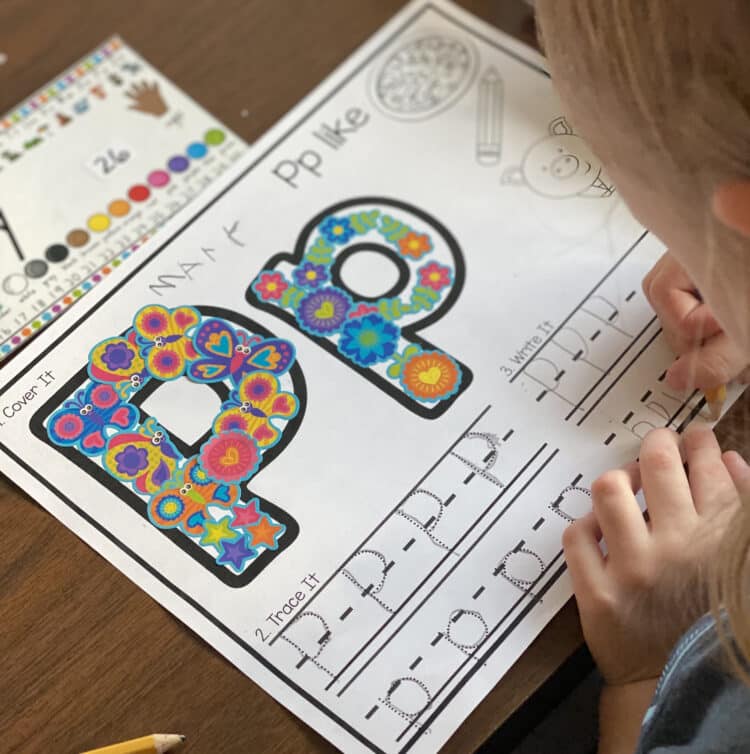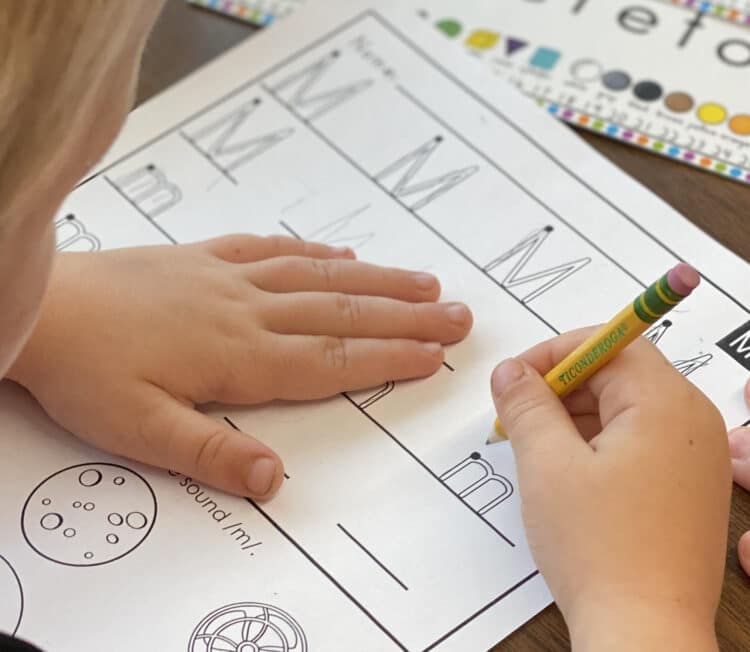Handwriting instruction can be tricky and frustrating for students and for teachers. With more and more students coming to early childhood classrooms with fewer and fewer fine motor skills, this is now more true than ever before. We can use as much handwriting help in kindergarten as we can get. I promise you, my classroom is no exception. You will see funky pencil grips in my classroom pictures. Sometimes you’ll see no grip at all. Students just don’t have the strength or stamina for fine motor when they come to me. Even the brightest students struggle with writing because the mechanics of handwriting and making letters is difficult for them. Students resist activities that involve writing because . . . well . . . it’s just hard.

Unfortunately, that means that early childhood teachers have their work cut out for them. The problem is that too often, handwriting is taught in isolation, a one-and-done-type instruction, and without support for building those skills so students can feel successful or repeated practice through multisensory activities. We know better, but time is short, and the demands on little people are high. Too often, a pencil is put in a hand without realizing that the muscles needed to hold that hand may not be ready, hand-eye coordination may not yet be developed and experience with moving along a path of motion may be non-existent. So, what do we do to get students where they need to be with the support they need?

Well, it’s more than just putting a pencil in a hand and saying ‘write.’ There is a lot of groundwork and support that needs to be in place. There have to be lots of opportunities to practice so that when that paper and pencil does come out, they feel like they want to write because they are successful and confident. Let me show you what that looks like in my own classroom
Dedicated Fine Motor Practice Time
One of the biggest obstacles is finding the time . . . dedicated time to build fine motor . . . the first step in writing . . .is basically non-existent in ever demanding early childhood classrooms. It was non-existent in mine, so I knew I had to find a way.
Morning arrival is when fine motor practice happens. For years, morning arrival time was my least favorite part of the day. Students come wandering in at all times of the morning. I would be trying to get my daily morning chores done, attendance, notes from parents . . .you know the routine . . . and hoping that the worksheet I gave my sweet kinders would ’keep them occupied until I could finish up and everyone had arrived ready to learn. It was horrible.

So several years ago, I initiated fine motor morning workstations. My mornings are now my favorite time of the day. More importantly, my students love this time of the day so much that they are anxious to get to school and arrive on time.
Take a little peek at what mornings were like right before Christmas break last year:
Let me show you exactly how I support fine motor during Morning Work Stations. I can show you how I set them up and organize them. You know, all the details. So just click here and you can see check it out.
Now how do we support letter recognition with hands-on fine motor letter work?
Letter Building Activities
Now that I eeked out some dedicated time for fine motor, I wanted to gather activities that would support recognition of letters and sounds in my literacy centers. I’m just not a one-time-and-done kind of teacher. Students need to see those letters, build them and create them using various multisensory tools to recognize them and reproduce them with fluency later.
Especially with young children, concepts, and skills need to be offered multiple times using lots of different activities. So, when we are learning about letters and letter formation, I offer students the opportunity to build letters to reinforce recognition and practice formation. Because I utilize a Daily 5-type literacy station structure, my students get plenty of hands-on letter building.
You don’t have to use a bunch of fancy-schmancy store-bought products to make this happen. Surprisingly, everything you need is probably in your teaching cupboard. A variety of materials and tools will allow you to tap into different multiple intelligence and keep students engaged. My favorite tools are stickers, q-tips, flat glass marbles, table scatter, mini erasers, watercolors, and whatever I can find in my cupboard. You can see where I collect some of my favorite manipulatives by click HERE.
You can see the different activities I use in the collage below. Also, if you’d like to learn more about all these activities, where I procure materials, and how they work, just click on the picture to take you to the post with that information.
What about writing tools? Read on to find out more!
Variety of Writing Tools
Once you have built those muscles and supported letter/sound recognition by building those letters in multiple ways, it’s time to put something in that hand. You will need a variety of tools to help them start following that path of motion. They will need a variety of tools to help make those squiggles, and curves that make up letters.
Don’t feel that you are limited to your favorite, adult-sized Ticonderoga No. 2 pencils. Students can produce letters using a variety of tools. Watercolors, smelly markers, highlighters, crayons, dry-erase markers, and golf-size pencils all have their advantages and disadvantages. If a pencil isn’t working for your student, try something else. Yes, I even use turkey feathers.

I find that my students often do better initially with small dry-erase markers. They slide a bit easier on a piece of laminate. My students especially like it when I let them practice with dry eraser markers on the table.
And if pencil grip is an issue . . . seek out your school’s occupational therapist. I like to say that “in my next life I am going to be an OT.” I feel like I have learned so much from my own school’s OT expert. Just when I think I have all the tricks figured out . . . she comes up with something new like this little monkey holder thingy she handed to one of my littles who came back to me in January after having never stepped foot in a school nor attending virtually. This little device was the ticket to happiness and success for him. Writing wasn’t so ‘hard’ after a short while.
If you’d like to see my favorite pencils for handwriting and pencil grips, you can check them out HERE.
But what about the mechanics of handwriting instruction? I have my opinion about what’s best. Read on to see what works for me.
Clear Plan For Instruction
Years ago, when I started in a state-funded preschool program in Michigan, I was trained in Handwriting Without Tears as a way of introducing handwriting to young children. I’m a big fan of HWT (Handwriting Without Tears). I believe it is a program that is both multisensory and developmentally appropriate for little people. From building Mat Man and the Mat Man song to building letters with wooden pieces, HWT doesn’t put the cart before the horse. Students build upon their skills to become confident writers. For those students who struggle with the path of motion or who haven’t quite mastered a solid, cradled pencil grip, HWT was just easier for them to find success.

When I started teaching kindergarten, I knew that I wanted to incorporate many of the same techniques of HWT. However, there wasn’t a huge variety of differentiated materials available for my students to use when practicing letter formation and handwriting. Also, I read that the graphic representation for the beginning letter sounds on your small group instruction charts, tracing books and any letter posters you might use should be consistent throughout your classroom. For me, that also meant that I wanted to be sure the initial handwriting pages that I offered students also utilize those same graphics. But finding those printables and finding them differentiated was pretty much impossible.
Luckily, a couple of years ago, I stumbled upon this HWT-type font and it has allowed me to build different handwriting practice sheets . . .
so that now, my reading materials’ (my classroom posters, charts, and tracing books) finally match my handwriting printables. I am currently using Phonics First in my classroom so these graphics support that program, too.
By having those elements all in place, I’m doing the best I can to set up my kinders for success in handwriting and letter recognition. But what about those kids that already have a good grasp of their letters? They know letters but STILL can not form a letter to save their little souls. Well, they need that support to succeed with handwriting just like students starting out with little letter recognition. But we seldom see handwriting support that will challenge those students and still guide them with handwriting. Students get pushed onto more complex skills, but handwriting just never catches up. Bad habits are developed that continue and, often, are never corrected.
I hate that. So I have handwriting practice pages that are ‘just right’ for all the students in my class. Because my gosh, everyone needs to start those dang letters at the top.
By using differentiated printables, I can laminate or print off pages for students who are still just starting out with letter recognition. Similarly, I can give students who are working on beginning sounds, blending CVC words, or even writing sentences what they need, too. All students will be challenged just enough to stay engaged and feel successful. (Insert deep sigh of relief here!)
If you’d like to see more HWT-style resources, check out this Early Learners HWT-style bundle.
Provide Opportunities To Practice and Play Writing
Finally, the last bit of advice I would give you. . . Give your students lots of opportunities to play and experiment with writing. Give students the opportunity to use writing for fun without being micro-managed about strokes and pencil grip. Yes, the mechanics are important. That’s why you use your dedicated handwriting time to work on those skills. However, don’t forget to let your students learn to love writing for all the fun it can bring them. Add paper and writing utensils to your block centers, dramatic play, and even your cars. It will surprise you to see your students using their skills in ways that are meaningful to them.
Pin It!
If you enjoyed this blog post, please consider pinning this.




















Leave a Reply